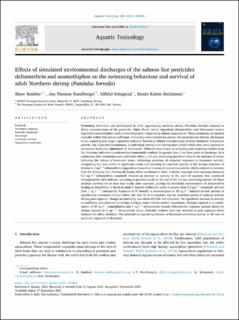Effects of simulated environmental discharges of the salmon lice pesticides deltamethrin and azamethiphos on the swimming behaviour and survival of adult Northern shrimp (Pandalus borealis)
Peer reviewed, Journal article
Published version
Permanent lenke
https://hdl.handle.net/11250/2789232Utgivelsesdato
2021Metadata
Vis full innførselSamlinger
- Publikasjoner fra Cristin - NIVA [2149]
- Scientific publications [1172]
Sammendrag
Swimming behaviour was investigated in adult egg-carrying northern shrimp (Pandalus borealis) exposed to dilute concentrations of the pesticides Alpha Max® (active ingredient deltamethrin) and Salmosan® (active ingredient azamethiphos) used to control parasitic copepods in salmon aquaculture. These treatments are applied topically within fish nets or well boats. Following a short treatment period, the pesticides are directly discharged to sea, exposing non-target organisms such as P. borealis to diluted concentrations of these chemicals. Locomotor activity was measured continuously in individual shrimp over several days within which they were exposed to treatments of diluted AlphaMax® or Salmosan®. Dilutions were based on modelling and dispersion studies from the literature and were considered environmentally realistic for greater than 1 km from point of discharge. 24 h continuous flow treatments were delivered within a 3.5-day monitoring period to observe the timeline of events following the release of treatment water, addressing questions of temporal responses in locomotor activity, recognising key time points of significant events and assessing the survival capacity of the shrimp. Exposure of shrimp to 1 ng l−1 deltamethrin triggered an immediate increase in swimming activity which reduced in intensity over the following 22 h leaving all shrimp either moribund or dead. A further exposure trial exposing shrimp to 0.2 ng l−1 deltamethrin (nominal) showed an increase in activity at the start of exposure that continued throughout the 24 h delivery, returning to previous levels by the end of the 3.5-day monitoring period. All these shrimps survived for at least four weeks after exposure, putting the threshold concentration of deltamethrin leading to immobility or death in adult P. borealis within this study at greater than 0.2 ng l−1 (nominal) and less than 1 ng l − 1 (measured). Exposure of P. borealis to azamethiphos at 30 ng l−1 induced several periods of significantly increased activity within the first 10 h of exposure and an extended period of reduced activity during post exposure, though no morbidity was observed with this treatment. No significant increase in activity or morbidity was observed in shrimp during a water vehicle control assessment. Shrimps exposed to a combination of 30 ng l−1 azamethiphos and 1 ng l−1 deltamethrin broadly followed the response pattern shown by shrimp exposed to 1 ng l−1 deltamethrin alone. Pesticide residues were not detected in post exposure tissue analyses for either chemical. The potential ecological significance of increased swimming activity at the start of pesticide exposures is discussed.

